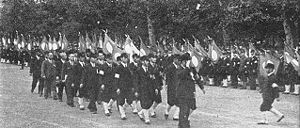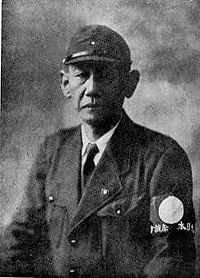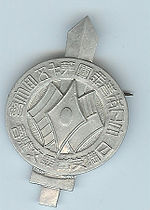
Imperial Youth Federation
Encyclopedia



Empire of Japan
The Empire of Japan is the name of the state of Japan that existed from the Meiji Restoration on 3 January 1868 to the enactment of the post-World War II Constitution of...
modeled after to Nazi Germany
Nazi Germany
Nazi Germany , also known as the Third Reich , but officially called German Reich from 1933 to 1943 and Greater German Reich from 26 June 1943 onward, is the name commonly used to refer to the state of Germany from 1933 to 1945, when it was a totalitarian dictatorship ruled by...
's Hitler Youth
Hitler Youth
The Hitler Youth was a paramilitary organization of the Nazi Party. It existed from 1922 to 1945. The HJ was the second oldest paramilitary Nazi group, founded one year after its adult counterpart, the Sturmabteilung...
.
History
The Dai-Nippon Seinento was a youth organization founded by ultranationalist activist Colonel Kingoro HashimotoKingoro Hashimoto
was a soldier in the Imperial Japanese Army and politician.-Early career:Hashimoto was born in Okayama City, and a graduate of the 23rd class of the Imperial Japanese Army Academy in 1911. He subsequently graduated from the Army Staff College in 1920. In April 1922, he was assigned to the Kwangtung...
on October 17, 1937, following Hashimoto's temporary forced retirement from military service due to his involvement in the failed February 26
February 26 Incident
The was an attempted coup d'état in Japan, from February 26 to 29, 1936 carried out by 1,483 troops of the Imperial Japanese Army. Several leading politicians were killed and the center of Tokyo was briefly occupied by the rebelling troops...
attempted coup d'etat
Coup d'état
A coup d'état state, literally: strike/blow of state)—also known as a coup, putsch, and overthrow—is the sudden, extrajudicial deposition of a government, usually by a small group of the existing state establishment—typically the military—to replace the deposed government with another body; either...
against the government.
Hashimoto modeled the organization after the Hitler Youth
Hitler Youth
The Hitler Youth was a paramilitary organization of the Nazi Party. It existed from 1922 to 1945. The HJ was the second oldest paramilitary Nazi group, founded one year after its adult counterpart, the Sturmabteilung...
of Nazi Germany
Nazi Germany
Nazi Germany , also known as the Third Reich , but officially called German Reich from 1933 to 1943 and Greater German Reich from 26 June 1943 onward, is the name commonly used to refer to the state of Germany from 1933 to 1945, when it was a totalitarian dictatorship ruled by...
, even to the extent of using a light brown color for member’s uniforms, and the adoption of a red banner with a white circle in the center as the party banner. The first party rally was held on the grounds of Meiji Shrine
Meiji Shrine
', located in Shibuya, Tokyo, is the Shinto shrine that is dedicated to the deified spirits of Emperor Meiji and his wife, Empress Shōken.-History:...
in downtown Tokyo
Tokyo
, ; officially , is one of the 47 prefectures of Japan. Tokyo is the capital of Japan, the center of the Greater Tokyo Area, and the largest metropolitan area of Japan. It is the seat of the Japanese government and the Imperial Palace, and the home of the Japanese Imperial Family...
, with approximately 600 members.
The stated aim of the party was to teach Japanese youth basic survival skills, first aid
First aid
First aid is the provision of initial care for an illness or injury. It is usually performed by non-expert, but trained personnel to a sick or injured person until definitive medical treatment can be accessed. Certain self-limiting illnesses or minor injuries may not require further medical care...
, life skills, cultural lessons, traditions and basic weapons training. However, Hashimoto's primary intent was to create an idealistic young cadre of supporters for the Imperial Way Faction
Imperial Way Faction
The was a political faction in the Imperial Japanese Army, active in the 1920s and 1930s and largely supported by junior officers aiming to establish a military government, that promoted totalitarian, militarist, and expansionist ideals...
and its nationalist and militarist doctrines.
During the third party rally, held in Hibiya Park
Hibiya Park
is a park in Chiyoda City, Tokyo, Japan. It covers an area of 161,636.66m2 between the east gardens of the Imperial Palace to the north, the Shinbashi district to the southeast and the Kasumigaseki government district to the west....
, Tokyo with some 2000 members in November 1939, Hashimoto expressed his support for the upcoming Tripartite Alliance
Tripartite Pact
The Tripartite Pact, also the Three-Power Pact, Axis Pact, Three-way Pact or Tripartite Treaty was a pact signed in Berlin, Germany on September 27, 1940, which established the Axis Powers of World War II...
with Nazi Germany and Fascist Italy
Kingdom of Italy (1861–1946)
The Kingdom of Italy was a state forged in 1861 by the unification of Italy under the influence of the Kingdom of Sardinia, which was its legal predecessor state...
, and for a one-party system of government in Japan. He also set the ambitious goal of growing party membership to 100,000 members by the end of 1940.
However, with increased military conscription
Conscription
Conscription is the compulsory enlistment of people in some sort of national service, most often military service. Conscription dates back to antiquity and continues in some countries to the present day under various names...
due to the Second Sino-Japanese War
Second Sino-Japanese War
The Second Sino-Japanese War was a military conflict fought primarily between the Republic of China and the Empire of Japan. From 1937 to 1941, China fought Japan with some economic help from Germany , the Soviet Union and the United States...
and subsequently with the Pacific War
Pacific War
The Pacific War, also sometimes called the Asia-Pacific War refers broadly to the parts of World War II that took place in the Pacific Ocean, its islands, and in East Asia, then called the Far East...
, most of his target age group was being drafted into the Japanese military, and the party fell far short of its goals. Although not specifically a “political party
Political party
A political party is a political organization that typically seeks to influence government policy, usually by nominating their own candidates and trying to seat them in political office. Parties participate in electoral campaigns, educational outreach or protest actions...
” per se, the Great Japan Youth Party fell under the overall aegis of the Imperial Rule Assistance Association
Taisei Yokusankai
The was Japan's para-fascist organization created by Prime Minister Fumimaro Konoe on October 12, 1940 to promote the goals of his Shintaisei movement...
organized by Prime Minister
Prime Minister of Japan
The is the head of government of Japan. He is appointed by the Emperor of Japan after being designated by the Diet from among its members, and must enjoy the confidence of the House of Representatives to remain in office...
Fumimaro Konoe
Fumimaro Konoe
Prince was a politician in the Empire of Japan who served as the 34th, 38th and 39th Prime Minister of Japan and founder/leader of the Taisei Yokusankai.- Early life :...
from October 1940.
Unable to achieve his goals in Japan, and sidelined by actions of the government, Hashimoto returned to Manchukuo
Manchukuo
Manchukuo or Manshū-koku was a puppet state in Manchuria and eastern Inner Mongolia, governed under a form of constitutional monarchy. The region was the historical homeland of the Manchus, who founded the Qing Empire in China...
in late 1940, where he attempted to create another local youth organization similar to the Great Japan Youth Party among the Japanese settler population, with an equal lack of success.
By the end of World War II
World War II
World War II, or the Second World War , was a global conflict lasting from 1939 to 1945, involving most of the world's nations—including all of the great powers—eventually forming two opposing military alliances: the Allies and the Axis...
, the Great Japan Youth Party had devolved into little more than a defunct youth wing of the Imperial Rule Assistance Association, and was dissolved along with that organization by order of the American occupation authorities
Supreme Commander of the Allied Powers
Supreme Commander of the Allied Powers was the title held by General Douglas MacArthur during the Occupation of Japan following World War II...
.

